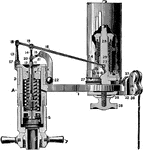
Three Way Pipe Valve for Attaching One Steam Engine Indicator
"If only one indicator is to be used for both ends of the cylinder, it may be connected by side pipes…
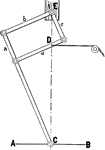
Motion Reduction using Pantograph of Piston Connected to Indicator of Steam Engine
A pantograph used to reduce motion of the piston. At point D, a string is attached to the indicator,…
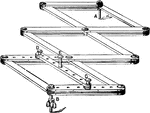
Horizontal Pivot Pantograph for Motion Reduction between Piston and Steam Engine Indicator
"It is placed horizontally with the pivot, B, resting on a support opposite the crosshead when in mid—position.…
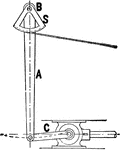
Reducing Motion of Piston and Indicator using Brumbo Pulley
A pulley system used to reduce motion between the piston and the indicator of the steam engine. The…
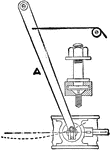
Reducing Lever for Piston and Indicator in Large Steam Engines
A reducing lever for large engines to measure pressure of steam in the cylinder. The string to the indicator…

Rope Brake Measuring Brake Horse Power
"The spring balance, B, is shown in a horizontal position. The ropes are held to the pulley or fly—wheel…

Shaft in an Eccentric Motion from Steam Engine
"As the eccentric turns in the strap, the point O moves in the dotted circle around O', and the point…

Slide Valve of Steam Engine
"The amount that the valve overlaps the steam ports is called the lap of the valve. It will at once…

Valve with Lap of Steam Engine Where Steam Enters the Slide Valve Compartment
"The maximum displacement of the valve is attained when the eccentric is horizontal. In this position…

Valve with Lap of Steam Engine at Extreme Left with Exhaust Ports Open
"Since the valve must move a distance equal to the outside lap before admission can take place, it is…

Steam Engine Valve with Lap Where Steam is Admitted to the Slide Valve
"While the crank is moving from the position, steam is being admitted to the head end and being exhausted…

Steam Engine Valve with Lap Steam Where Slide Valve is Closed
"The relative positions of crank, eccentric and valve when the exhaust closes on the crank end and compression…

Steam Engine Valve with Lap Steam Where Slide Valve Moved to Open Position
"If the inside lap is increased, the valve must move farther before released occurs and the crank angle…

Steam Engine Valve with Lap Steam Where Slide Valve is in Open Position
An illustration of the valve with lap at the end of the crank end steam compression. The piston will…
Steam Engine Valve with Lap Connected to Rocker
"This occurs in horizontal engines when the valve is set on top of the cylinder instead of on one side.…

Steam Engine Valve Centered with Piston
"It is usual to put the engine on center before setting the valve. First put the engine in a position…
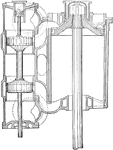
Cross Sectional View of the High Pressure Cylinder of Piston Valve from USS Massachusetts
"This valve consists of two pistons connected by a sleeve through which the valve rod passes. This valve…

Eccentric Motion of the Steam Engine Crank in Full Gear
"When set full gear forward, the valve admits steam to the crank end of the cylinder, and the crank…

Steam Engine Rocker Arrangement with Valve and Reverse Rod in Eccentric Motion
"This arrangement makes it possible to place the valve and steam chest above the valve motion. A rod…

Steam Engine Gooch Link and Valve Gear Arrangement
"As the speed increases, and the link is 'notched up', the lead is increased as the cut—off is…
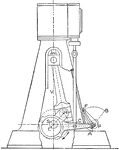
Outline of a Steam Engine Marshall Gear Reducing Friction and Wear
An outline of the Marshall gear from a steam engine. The piston rotates the crank shaft at point H around…

Joy Steam Engine Valve Gear Rotating Wheel
A Joy valve gear for steam engine rotating the wheel in the direction of the arrow. The lever F changes…

Steam Engine with Walschaert Gear on Railroad
An illustration of the steam engine with Walschaert gear system on rail tracks. The piston moves the…
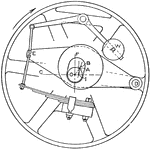
Top View of the Fly Wheel Governor Turning Clockwise
"All fly—wheel governors operate by shifting the eccentric either to change the angular advance,…
Close up View of Double Sliding Valve Gears from Steam Engine
"The main valve controls admission, release, and compression; the other (valve) regulates the cut—off…

Steam Engine with Reynolds Corliss Gear
"An eccentric on the main shaft gives an oscillating motion to a circular disc called the wrist plate,…

Close up of Reynolds Corliss Gear from Steam Engine
"The steam arm is keyed to the valve spindle which passes loosely through a bracket on which the bell—crank…
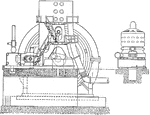
5000 kW Corliss and Curtis Steam Engine for Electric Generation
An illustration of a Corliss steam engine to generate 5000 kW of electricity. The turbines to create…
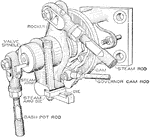
Steam Engine Brown Releasing Gear
"The governor cam rod operates a plate cam having a curved slot so shaped that it takes place of both…
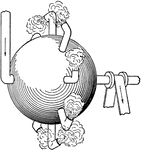
Hero's Simple Steam Turbine
A simple steam turbine by Hero of Alexandra during first century AD. The turbine consists of a hollow…
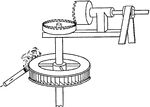
Branca's Impulse Steam Turbine
"In 1629, Branca, an Italian, invented a turbine much like a miniature water wheel, which was driven…
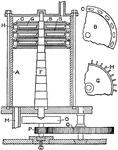
Real and Pichon Compound Steam Turbine
"A compound turbine was patented by Real and Pichon, the idea being to reduce the velocity of rotating…

Wilson's Compound Steam Turbine
"A view of Wilson's invention is shown; a, b, and c, are vance which are attached to and rotate with…

Hartman's Compound Impulse Turbine
"In 1858, Hartman Bros. patented a turbine consisting of two revolving disks c and c' fixed to a shaft…

Early Parsons Steam Turbine
"In 1885, Parsons took out his first turbine patent on a motor along the lines previously suggested…
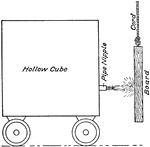
Apparatus for Measuring Jet Stream of Steam
"Suppose a hollow cube to be filled with some fluid (water or steam) at a given pressure, and to have…

Water Jet Deflected 90 Degrees Measuring Force
"If the velocity of impact of the jet is V feet per second, its velocity in the same direction after…
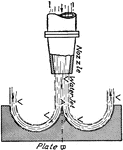
Force Measurement by Deflecting Water Jet 180 Degrees
"Now if the plate were shaped as shown, so that the direction of the jet were completely reversed turned…
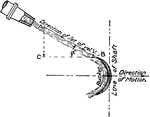
Jet Steam Stream Hitting Curved Vane
"If a jet with the velocity V strikes the bucket at an angle a, its velocity A B could be resolved into…
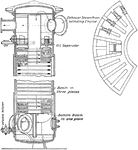
Interior View of Rateau Accumulator
"The accumulator may consist of a large tank in which are numerous plates over which water can flow,…

Westinghouse Turbo Steam Engine Generator Plan
"Turbines require very much smaller foundations than reciprocating engines reciprocating engines of…
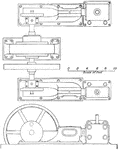
Corliss Steam Engine Generator Plan
"By placing the condensers underneath the turbine, as is frequently done at the present time, not only…

DeLaval Steam Electric Generator
"The bearings are of the plain ring—oiling type, usually provided with water jackets. The shaft…

Cross Section View of Rateau Turbine Electric Generator by Western Electric Company
A cross sectional view of Rateau electric generator turbine by Western Electric Company. Steam is used…

Zoelly Condensing Turbine Electric Generator
"The Zoelly turbine has been developed rather extensively abroad, and is being manufactured largely…

Sectional View of Kerr Turbine
"The shaft, where it passes through the diaphragm, is fitted to a bronze bushing with a few thousandths…

9000 Kilowatts Vertical Curtis Turbine
An illustration of 9000 kilowatts capacity vertical Curtis turbine. Each turbines are located between…

Cross Sectional View of U.S.S Salem Steam Engine Showing Curtis Turbines
"The marine turbine of this type (Curtis turbine) installed in the U.S. Cruiser Salem had seven pressure…
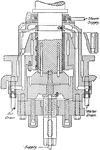
Cross Sectional View of Curtis Turbine Step Bearing
"The upper bearing with dowel—pins and key fit into corresponding dowel holes and key—way…

Cross Sectional View of Four Stage Vertical Riedler Stumpf Turbine
A cross sectional view of a four stage vertical Riedler—Stumpf turbine. The steam enters and exit,…
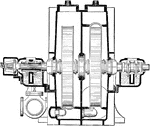
Cross Sectional View of Two Stage Condensing Terry Steam Engine Turbine
A two stage condensing Terry turbine from a steam engine. The steam, entering from the top, rotates…

Cross Sectional View of Parsons Turbine
"Steam enters at E and gradually expands in volume until it exhausts at G. The rotor is usually built…

Westinghouse Parsons Turbine Viewed Cross Sectionally
A cross sectional view of Westinghouse Parsons turbine. Steam enters at V and exits at E, turning the…
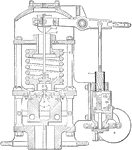
Sectional View of Governor for Varying Number of Nozzles Opened
"In the Curtis turbine, steam is admitted through a series of valves, the number of which depends upon…
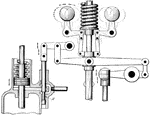
Turbine Governor for Varying Time of Admission
"An admission of steam occurs about once in every thirty revolutions at approximately full load. The…
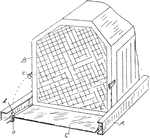
Device Radiator
A heating device consisting of a series of connected pipes, typically inside an upright metal structure,…
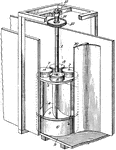
Water Turbine
Any of various machines having a rotor, usually with vanes or blades, driven by the pressure, momentum,…
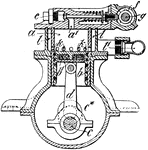
Steam Engine
External-combustion engine in which heat is used to raise steam which either turns a turbine or forces…
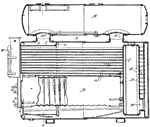
Steam Boiler
A heating unit designed to heat by boiling water, producing steam, and circulating it to radiators or…
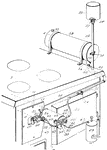
Steam Generator
Used to convert water into steam from heat produced in a nuclear reactor core. They are used in pressurized…